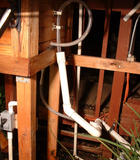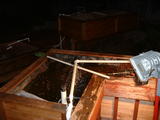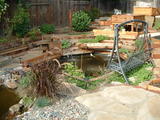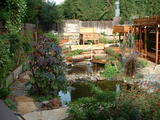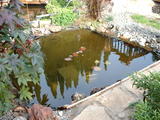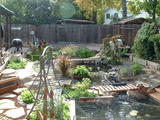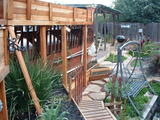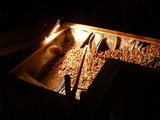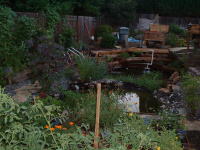So it's winter, and your compost isn't getting finished as fast as you would like. Here are a couple of things you can do that will help.
1. Cover the pile - Put some landscape cloth, large plastic bags, or a tarp over the pile. This helps keep the pile warm by containing the heat created during the process. Make sure you uncover the pile during the day a few times a week and mix up the pile a little bit to get oxygen into it. If you keep it covered all the time without mixing it, you might suffocate the microbes that need oxygen to break down the materials.
2. Pour your leftover hot water into the pile - Almost every day I boil something to eat. Instead of pouring the water down the drain when I am done, I pour it into the pile to warm it up. This will help a lot during the cold winter nights. Just getting the microbes warm enough to get working will keep the pile warm all night. Once they get going, they will create their own heat. This can help speed up the process enormously in winter.
3. Only turn your pile at night - Let the pile work its magic during the warmth of the day. Turn your pile while it isn't doing much in the cold of night. When you are done, the pile will be too cold, so add some
HOT water to help warm it up.
So while all of this helps speed up the process, it still might not be as fast as you would like. Maybe you need some compost today, and the pile isn't quite done yet. If it's been a month or two since you started the pile and it has been composting, just a little bit slow, there is a way to get the composted material out of the pile. It will take a little effort, but it can be done.
You will need a shovel, a wheelbarrow, and something to sift the compost with. I have used many things in the past as a sifter, including an old house fan front cover. It needs to be large, so a hand held kitchen strainer probably won't be large enough. Now I use the bottom from a store bought fire pit I have in my yard. It works perfectly and couldn't be better if I had made a sifter myself.
Get your wheelbarrow next to your pile and place the sifter over or in it and add the material you wish to sift. This photo shows the last bit of material I want to sift through(if you didn't notice the wheelbarrow is already full)...
Once you get a good amount in the sifter, go through it and remove any large visible items that haven't composted. Remove anything that doesn't need to be there, such as rocks and plastic. Use gloves! In the photo below I am not because I was taking a picture and didn't want to get my camera covered with rotting gunk. But generally you don't want to stick your bare hands into a compost pile.
After you have removed the visible stuff, start sifting. I find it works better to flip the material up and let it fall back into the sifter then quickly flip it again. Repeating until everything is spread out and falling through the sifter easily. This loosens up the stuck together stuff better than just moving the sifter from side to side. But once it is loose, moving from side to side works well also. Use both methods and sift until nothing is falling through the sifter. What you are left with inside the sifter will be the stuff returning to the pile.
Make a discard pile to temporarily keep the material that is going back into the main pile.


Keep going until your wheelbarrow is full or you don't have anything left to sift. Once done, what you have is good compost inside the wheelbarrow. If you want to make sure it's completely done, leave it in the warmest spot in the yard covered in something black, such as a plastic yard bag, for a few days. If you have a large oven and some large pots, you can stick it in your oven on 200F for a couple of hours, then set it back into the wheelbarrow, covered over night. Or do what I do, and use it just the way it is.

 **GREEN TIP
**GREEN TIP**
If you are like me and hate it when you buy something in a box, get it home, open it, and find a landfill nightmare in Styrofoam. So do you toss it in the landfill or find a use for it? Here is a great way to get rid of it and help aerate your soil. If you are interested in doing this, please read the entire post before you do it.
Break the Styrofoam into little chunks about an inch or two in size. Throw them into your compost bin for a few months. It won't break down, but it will get rid of that styrofoam smell and can help loosen up the tiny balls that compose the Styrofoam. Now, whenever you sift your compost you will run into these little chunks. Take them and scrape the sides of your sifter with them. This breaks it down into tiny little balls that fall into the compost. But...
DO NOT DO THIS IF YOU PLAN ON BAKING THE COMPOST IN AN OVEN! Instead let the balls fall into a bucket or something, then add them after you bake the compost.
When you are done sifting your pile you will have several layers of these balls in the compost.
Mix the compost well so that the little tiny balls of Styrofoam are not bunched together.
This will make the compost so light and fluffy you won't believe it.
About Styrofoam: Don't worry, Styrofoam takes 35 to 50 years to break down, so it will not harm your food if you use it in the garden. But if you absolutely want an organic vegetable garden, just use this compost in the flower garden or somewhere else. This is not considered an organic compost because of the Styrofoam. However, would you rather have it in the landfill doing harm and creating more waste, or in your soil doing some good? I think the latter is the better alternative.
Either way....
Happy composting!






































